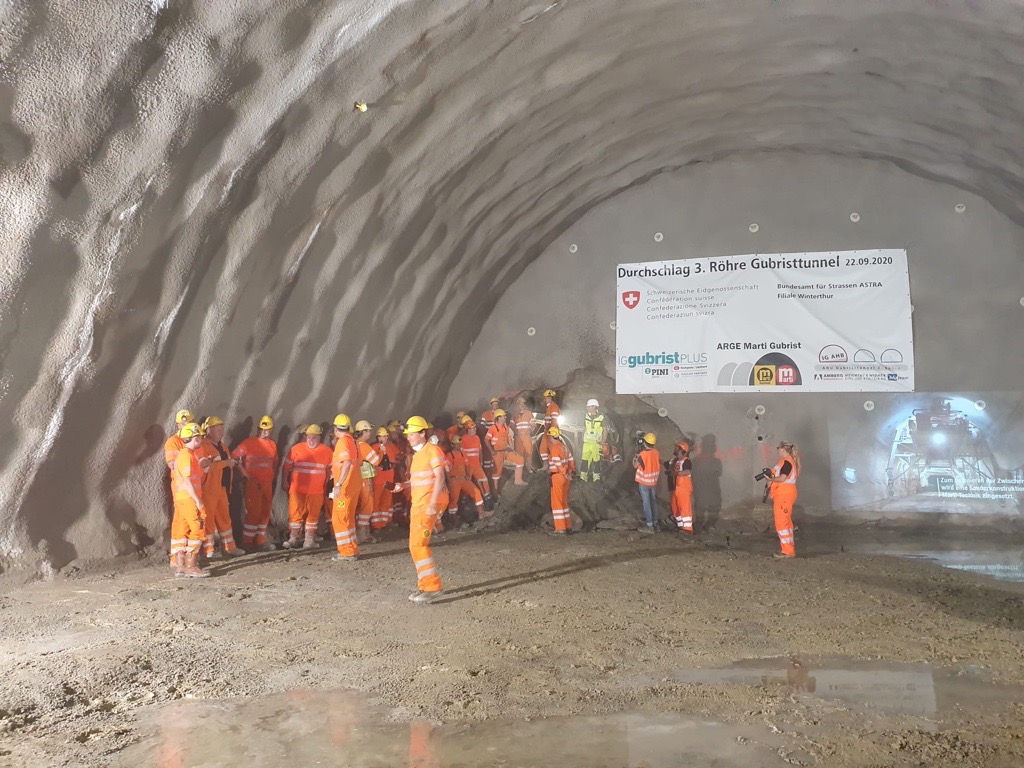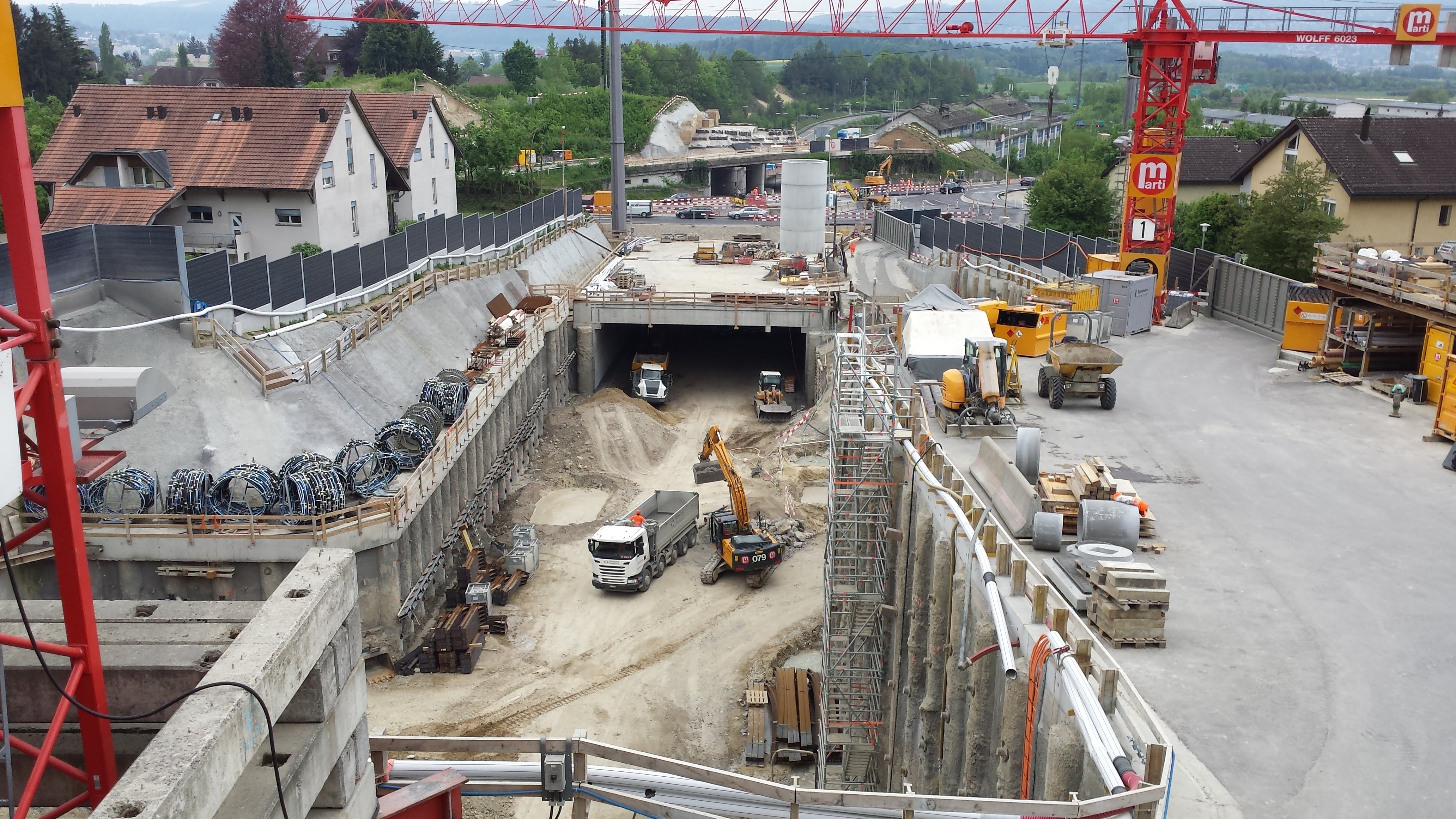The breakthrough of the third tube of the Gubrist tunnel occurred on September 22nd, 2020. The tunnel is the key element in the expansion of the Zurich Northern Bypass. With this another milestone in alleviating the most important bottleneck in the greater Zurich area was reached.
Since November 21, 2017, up to 150 miners have worked in 3 shifts to excavate the three-kilometer-long driven tunnel. Amberg Engineering AG has directed the AHB Engineering Association (Amberg Engineering AG, Meichtry & Widmer AG, BHAteam Ingenieure AG) working on the demanding new construction project since 2005. Incorporating the disciplines of foundation engineering, structural engineering and road construction, Amberg Engineering is responsible for the project development and on-site construction supervision of the driven tunnel.
Due to the ongoing corona situation, the event was celebrated with a strictly allocated contingent of the parties directly involved in the project. including Amberg Engineering as designers, representatives of FEDRO and the contractor ARGE Marti Gubrist. Nevertheless, the excellently organized occasion was duly celebrated by us.
We are now entering the final spurt in planning and implementation so that the renovation of the two existing tunnel tubes can take place from 2022. The goal is in sight: that we soon get through the Northern bypass without traffic jams. Good luck to our PM Nicole Arndt and her team!
A video of the breakthrough celebration by the client the Federal Road Administration of Switzerland ASTRA can be seen here.
THE GUBRIST TUNNEL: end of traffic jams in sight
The Gubrist Tunnel – The heart of the northern bypass
There is nowhere else in Switzerland where vehicles are stuck in traffic jams as frequently as before the Gubrist Tunnel. That means that traffic accidents are a common occurrence. In order to remedy this problem and diffuse the traffic situation for the future, the expansion of the northern bypass around Zurich has been approved and planned, and it is a key project for the FEDRO, Federal Roads Office.
Amberg Engineering AG has directed the AHB Engineering Association (Amberg Engineering AG, Meichtry & Widmer AG, BHAteam Ingenieure AG) working on the demanding new construction project already since 2005. Incorporating the disciplines of foundation engineering, structural engineering and road construction, Amberg Engineering is responsible for the project development and on-site construction supervision of the driven tunnel.
Our project team on site provides us with regular insights on their exciting activities as well as the current work progress. Take a look for yourself to see how far the project has already progressed.
3 km long driven tunnel
The driven tunnel was begun with a ground-breaking ceremony on the Affoltern side in November 2017. A good deal has already take place there with more that 80 m of advancement in the crown. At present, the tunnelling is still being carried out with an excavator and a cutting unit attachment. However, it is anticipated that soon a switch will be made to drill and blast. The current rate of advance is about 4 m per day deeper into the mountain.
Safety equipment and the Sunnenrain underground control centre
The new third tube includes eight man-sized and four trafficable cross-passages spaced at about 300 m which connect to the existing second tube. Moreover, there will be 25 combined SOS and hydrant refuges spaced at 150 m located on the outer side of the tunnel. Overall, three new control centres and two new ventilating stations will be constructed. There is a control centre and a ventilating station at each portal. Construction of the Sunnenrain subterranean control centre is planned at about the middle of the tunnel on the north side.
The design of this control centre is in progress and is being visualized primarily as a 3D model.
Weiningen portal
On the Weiningen side, the initial metres of the tunnel have also been dug by excavating under a 1.6 m thick concrete roof using the top-down method. In addition, the preparatory works for the re-routing of the Zürcherstrasse roadway planned for the coming months are in progress. The traffic will then be routed over the finished roof construction via a roundabout, thereby creating space for the next construction phases. The actual tunnelling in Weiningen is slated to begin in March. For this to take place, a pipe umbrella must be constructed first.
Affoltern portal
At the cut-and-cover site in Affoltern, the excavation and the associated revetment is being conducted at the same time as the tunnel construction itself with close coordination between the two tasks in order to avoid mutual obstructions. The installation site is also humming with activity: A second structure for accommodating workers has been constructed and the belt conveyor system and the crusher have already been installed.
First train leaves railway loading station
The construction site’s own railway loading station for removal of the excavated material estimated to amount to about 1 million tonnes passed acceptance in mid-December. The first freight train loaded with spoil left the loading station at the Affoltern tunnel portal on 8 February. Over the next two years, it is expected that 2 to 3 trains daily will remove a total of 700,000 cubic metres of rock. This will avoid the necessity of about 160,000 truck trips.
Would you like to find out more about the Zurich northern bypass or see a bird’s eye view of the project? Then have a look at the FEDRO project video on the expansion of the Zurich northern bypass or take a drone flight over the Zurich northern bypass. Have a good flight!
Facts & Figures on the Gubrist Tunnel:
- The existing Gubrist Tunnel with 2 tubes has been in operation since 1985.
- More than 100,000 vehicles roll through the Gubrist Tunnel daily.
- After the expansion, the northern bypass is to enable the transit of about 140,000 vehicles daily. This is the figure planners reckon with by the year 2040.
- The 3rd tube will complement the 3,250 metre long Gubrist Tunnel.
- The new 3rd tube will accommodate the traffic heading towards Bern and Basel. As with the Baregg Tunnel, the two existing tubes will be for travel in the direction of St. Gallen.
- The 3rd Gubrist Tunnel comprises the two cut-and-cover sections at the Affoltern and Weiningen portals as well as the driven tunnel section with a length of 3 km. The tunnel’s excavated cross-section is about 178 m2.
- The excavation of the rock will be accomplished with the drill and blast method.
- In addition, the Sunnenrain control centre with a volume of about 5,000 m³ will also be constructed underground.
- Another key factor apart from the cut-and-cover and tunnel driving work is the removal of about 1 million tonnes of excavated material. This spoil will be removed via the construction site’s own loading railway station.
- The construction work was begun in November 2016 with the groundbreaking and is slated to be finished in summer 2022.
- The beginning of the actual tunnel construction was celebrated in a ceremony on 21 November 2017.
- It is anticipated that the overall project (including construction of the third Gubrist Tunnel tube and expansion of the motorway to six lanes) will last until 2022. Afterwards, the two existing tubes of the Gubrist Tunnel will require renovations. This work is slated to be completed by 2025.
- The total costs will amount to about 1.55 billion CHF.










